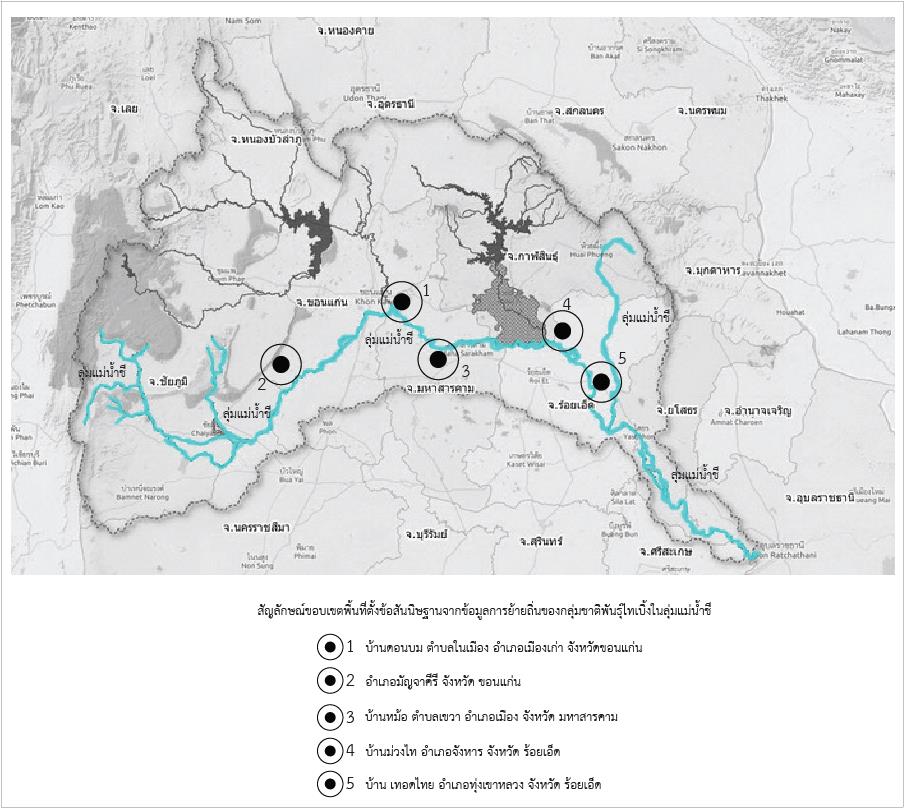A Study of Migration Ethnics Groups of Boeng -Tai in Chi River Basin
Main Article Content
Abstract
This article aims to explain a status of academic outputs in study of Migration Ethnics Groups of Boeng -Tai in Chi River Basin. The review of this article is based on 35 samples of academic outputs published during 1984-2017 A.D., i.e. texts, research reports, articles, conference papers and theses, then to present all analyzed data by description In difference of Spatial Ability space relationship to migration a study of Migration Ethnics Groups of Boeng -Tai in Chi River Basin and some related areas assumption and education in different of Spatial Ability to migration speculation of ethnic groups. The importance of the cultural landscape (Cultural landscape) The social, cultural, and economic structures linked to government in the period Which has identified relevant educational guidelines in the study found: 1)Spatial Organization 2)Culture Ecology 3)Historic Sites that affect Characteristics of ethnic groups or ethnic groups(Ethnographic Landscape) There are various study approaches and some related areas into 35main contents, study to area and cultural contexts from the vernacular house study overallobjectives of study Migration Ethnics Groups of Boeng -Tai in Chi River Basin into 2 types ofinformation. 1) Migration Ethnics Groups of Boeng -Tai in Chi River Basin into 12 main contents,2)Spatial Ability of Migration Ethnics Groups of Boeng –Tai into 23 main contents, to promotean interdisciplinary study.
And obtained a rationale from the study that Migration Ethnics Groups of Boeng -Tai have displaced immigrants. But most of them live in the boundaries of the central and northeastern regions of Thailand. Thus, resulting in an integrated culture Because it is a community that interacts with both regions.
From the study of Migration Ethnics Groups of Boeng -Tai in different residential areas Causing changes from the original Both in tradition the traditional tradition that fades away. Including the style of architecture that adjusts the lives Affecting the house that has been modified to add more space by using modern materials and construction technology to replace
Article Details

This work is licensed under a Creative Commons Attribution-NonCommercial-NoDerivatives 4.0 International License.
References
วิโรฒ ศรีสุโร, “ข้อสันนิษฐานว่าการตีหม้อที่มีอยู่ในพื้นที่ต่างๆ ของภาคอีสานนั้นส่วนใหญ่เป็นคนที่อพยพมาโคราชทั้งสิ้นจนมีคำกล่าวว่า ไทโคราชชอบตีหม้อแต่ลาวชอบทอผ้า”, 2528.
วิชิต คลังบุญครอง และไพโรจน์ เพชรสังหาร, เฮือนอีสาน. ในกรรมาธิการสถาปนิกอีสาน (บรรณาธิการ), สถาปัตยกรรมอีสาน, กรุงเทพฯ: เมฆาเพลส, 2535.
ชำนาญ บุญญาพุทธิพงศ์, ที่พักอาศัยชั่วคราวสำหรับชุมชนภาคอีสาน กรณีศึกษาจังหวัดขอนแก่น. คณะสถาปัตยกรรมศาสตร์ มหาวิทยาลัยขอนแก่น, 2535.
บันเทิง พูลศิลป์ , ความรู้เบื้องต้นเกี่ยวกับสถาปัตยกรรมอีสาน. ในกรรมาธิการสถาปนิกอีสาน, 2530.
ธิติ เฮงรัศมี และคณะ, การศึกษารวบรวมรูปแบบบ้านพักอาศัยในชนบทอีสานแถบลุ่มน้ำชี จังหวัด ขอนแก่น มหาสารคาม กาฬสินธุ์ ร้อยเอ็ด และยโสธร. คณะสถาปัตยกรรมศาสตร์ มหาวิทยาลัยขอนแก่น, 2536.
วิชิต คลังบุญครอง, สถาปัตยกรรมบ้านพักอาศัยพื้นเมืองของชาวไทยอีสานกลุ่มต่างๆ ไทย-ผู้ไท. คณะสถาปัตยกรรมศาสตร์ มหาวิทยาลัยขอนแก่น, 2535.
ธาดา สุทธิธรรม, การอนุรักษ์มรดกสถาปัตยกรรมพื้นถิ่นอีสานในแนวทางการมีส่วนร่วม. มูลนิธิภูมิปัญญา สิ่งแวดล้อมวัฒนธรรมและศิลปะเอเชีย, 2554.
ถนอม ตะนา และคณะ, การขยายตัวของชุมชนเมืองลุ่มน้ำชี กรณีศึกษา เมืองร้อยเอ็ดและยโสธร. กรุงเทพฯ: สำนักงานกองทุนสนับสนุนการวิจัย, 2554.
กาญจนา ตันสุวรรณรัตน์, สถาปัตยกรรมพื้นถิ่นโคราช. นครราชสีมา: รจนาการพิมพ์, 2556.
บัญชา นาคทอง, การศึกษาอัตลักษณ์เรือนพื้นถิ่นชุมชนบ้านนกออก ตำบลนกออก อำเภอ ปักธงชัย จังหวัดนครราชสีมา. คณะวิศวกรรมศาสตร์และสถาปัตยกรรมศาสตร์ มหาวิทยาลัยเทคโนโลยีราชมงคลอีสาน, 2557.
Richardson, New Vernacular Architecture. Hong Kong: Laurence King, 2001.


